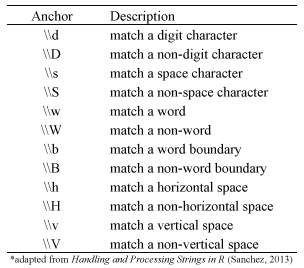
Https?://(This regex matches social security numbers. This regex matches email regex matches websites links ending with sites of. or represents an alphanumeric character. REGEX This is the REGEX pattern to test the validity of a URL: (http)(. Here’s a nice R package thst helps us do REGEX without knowing REGEX. Hence, finding some alternative is always very helpful and peaceful too. \d Backslash and d, matches digits 0 to 9, equivalent to or REGEX is that thing that scares everyone almost all the time. Conversely, Capital \W will match non-alphnumeric character and not underscore. \w Backslash and w, it is equivalent to, matches alphanumeric character or underscore. \n Backslash and n, represents a line break. For example, “\bwater” finds “watergun” but not “cleanwater” whereas “water\b” finds “cleanwater” but not “watergun”.

\b Backslash and b, matches a word boundary. For example, the below regex treats the period as a normal character and it matches a.b only. \ Backslash, turns off the special meaning of the next character. For example, the below regular expression matches the the characher q if the charachter after q is not a digit, it will matches the q in those strings of abdqk, quit, qeig, but not q2kd, sdkq8d. That means when you use a pattern matching function with a bare string, it’s equivalent to wrapping it in a call to regex (): The regular call: strextract (fruit, 'nana') Is shorthand for strextract (fruit, regex ('nana')) You will need to use regex () explicitly if you want. ! Exclamation, do not matches the next character or regular expression. Regular expressions are the default pattern engine in stringr. For example, the below regular expression matches col,cool,…,cooooooooooool,… + Plus, matches 1 or more characters in fron of the plus. For example, the below regular expression matches cl,col,cool,cool,…,coooooooooool,… * Asterisk, matches 0 or more characters in front of the asterisk. For example, the below regular expression matches apple and apples. ? Question mark, matches 1 or 0 character in front of the question mark. For example, the below regex matches, , and. ( ) Parentheses, groups one or more regular expressions. For example, the below regex matches kam, kbm, kcm, k2m, k3m, k4m and k5m. – Hyphen, used for representing a range of letters or numbers,often used inside a square bracket. For example, the below regex matches bad, bed, bcd, brd, and bod. Square brackets, matches any single character from within the bracketed list. For example, the below regex matches a paragraph or a line ends with bye. $ Dollar sign, matches a term if the term appears at the end of a paragraph or a line. ^ Carat inside a bracket, for example, the below regex matches any characters but a, b, c, d, e. For example, the below regex matches a paragraph or a line starts with Apple. ^ Carat, matches a term if the term appears at the beginning of a paragraph or a line. For example, the below regex matches shirt, short and any character between sh and rt. Period, matches a single character of any single character, except the end of a line.


 0 kommentar(er)
0 kommentar(er)
